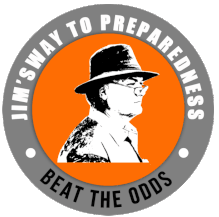
One of the Late Great Men…
James Gilbert Phillips Jr.
August 16, 1947 — January 15, 2024
This man touched my life…
Jim wrote Chapter 23 of my book the Civil Defense Manual… “Shelter and weather issues, Phillips on Hypothermia”
I’m re-posting Jim Phillip’s newsletter essay from 2 years ago as my dedication to this exceptional human being. Jim was one of the world’s foremost experts on cold weather survival. His military credentials alone confirm that.
In addition, he taught thousands of other Federal, State, County, Local personnel and scores of thousands of civilians everywhere how to survive in the deadly cold of Winter.
Jim would want this… he had a passion for educating people to perils. He may be gone… but read what he would want you to know if you get stuck out in the cold.
From Alaska to Norway to Pakistan… Jim taught the following military units how to maneuver in and survive cold weather…
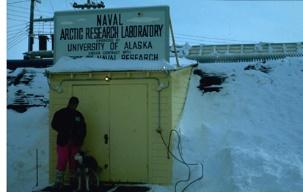
U.S. Army
The 11th Armored Cavalry Regiment
The 6th Infantry Division
The 9th Infantry Division
The 2nd Infantry Division
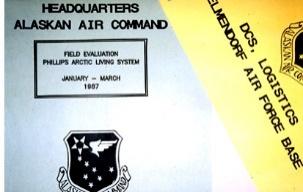
The US Army Natick Laboratories
Officers of the Army Staff and Secretariat
U.S. Air Force
USAF Alaska
U.S. Marine Corps
Northern Warfare Test Center
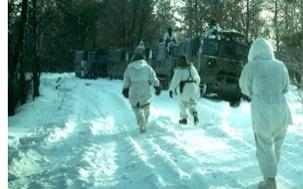
The 2nd Marine Regiment
HQ USMC
Foreign Armies
The Norwegian Army
The Pakistani Army
Keeping that warm and fuzzy feeling when the lights go out, the natural gas stops, there’s no heat… and you don’t have a wood burning fireplace… or the wood…
My guest Author of this essay, Jim Phillips, is a Cold Weather Survival Expert. He has taught cold weather survival to the Norwegian and Pakistani Armies, along with most American branches of our military and agencies of the Federal and many State governments and thousands of civilians.
Jim tells you here what to do during a Cold Weather Emergency… a Severe Winter Cold Snap, at Home, Power Off, No Heat, Unprepared wherever you live… just like those Texans went through for over a week in February 2021… after the thought of “We have wind turbines and solar panels… our power system can’t fail!” A “Blackout.”
This had been sold to them by environmentalists, power companies and the government… and then it failed.
Jim Phillips on Emergency Cold Weather Survival for the Unprepared
Human Nature
It’s happened before; it will happen again. Human nature is to avoid (ignore) unpleasant possible future events. This article is written for the “average Jack and Jill American,” unconcerned that things just happen (some dangers repeat again and again). They’ve made zero emergency preparations for severe winter cold at home, except to pay the bills and assume the utilities will always be there. They think… “If the power and heat are not there, there will be holy-hell to pay for the incompetent morons that did this to me!!!!”
The mere fact that you have read this far means you do not fit the “average Jack and Jill American” profile of someone totally unprepared to be on their own at home alone with no utilities. Once you have finished reading this, you will at least have more concepts, ideas, and questions in your subconscious that will quietly move you ahead to improved levels of readiness. And if you then take preemptive action—WOW—the results will be improved physical comfort, internal peace, and a calming influence on others during such an event.
I’m not going to use the typical approach for preparedness instruction. What you commonly get on YouTube, classes, survival books, preparedness podcasts, and sales literature is the “cookbook approach”—a list of ingredients with a recipe for a specific result. All valuable information, as far as it goes, but fails
to teach underlying principles of how and why things really work in the materials world and human physiology. There is a failure for people to obtain the understanding so they can extrapolate solutions to situations outside of what’s been presented in the “cookbook.”
my approach in the preparedness arena is to present principles on how and why things work, what the true needs and priorities are, and how to develop the mental/emotional attitude to make it, no matter what. Jim Phillips
www.jimsway.com and The Provident Living Times.
Okay, back to the clueless—which you are not going to be if you read and understand this...
A Future “2021 Texas” Event at Your Abode

For you It’s really cold, say Austin, TX on Feb 16, 2021, @ 6°F (-14°C), or Dallas, TX on the 16th @ -2°F (-19°C), then there’s Jacksboro, TX on the 16th @ -11°F (-24°C). Demands for power and heat (delivery of natural gas, propane, furnace-oil, power) are off the charts. Wires, pipes, meters, computers, controls and people are seriously strained.
Some little thing goes snap, pop, crunch, crinkle, or kerplop… then the whole thing goes kablooey! That one thing ripples out and spreads through more than one interconnected system leaving you alone at home, on your own, in the dark, with the increasing cold. NOW, WHAT!!!
First Easy Actions
Is the event just affecting you or others, and how widespread is it? The underlying questions are— When will this end? Is there help coming? Am I on my own? How do I get answers?
If it’s nighttime and depending on where you live, look out the window; how much manmade light do you see? Do the neighbors’ have lights? Are the street lights on? Is there sky-glow from city-scape light? How about car lights?
Each level of “not seeing normal night lights” will direct your thoughts to what may have happened, how bad it is, and how you should be responding.
During the day—at night also—check your normal channels of communication that are not directly dependent on utility power: cell phone, land-line, portable radio, car radio, handheld walkie-talkie (CB, GMRS, 2-meter, etc.) smart-phone internet connection, etc. Each of these working—or not working—gives a hint as to the affected area, possible duration, when things may come back, or when you might get help.
A-Your Reality
After checking… if it’s obvious that this is really serious and it’s widespread. You will know that things are not going to get back to normal for many days (weeks?). Conditions are such that you must understand that no help will be coming and you cannot get out for days.
You’re wishing you had taken some of the advice you’d heard about being prepared for such an event. Life has been so darn busy and there have been so many seemingly pressing demands on your time and budget.
But, it’s too late and a waste of energy now to regret not being prepared. You are where you are and have what you have. There are two basic choices:
- Curl up into a mental fetal position believing it will all go away and THEY will come to the rescue, or
- Get on with solving the critical issues at hand as best you can with what you have, vowing to never get caught like this again.
[“THEY” is anybody but you… the government, neighbors, National Guard, Police, Fire Department, Emergency Medical Technicians, Federal Emergency Management Agency (FEMA). They may get to you… but they’re having the same problems as you so WHEN they get to you it will probably be too late. You are the only one coming to your aid.]
B-Missing Resources
At first, you’re going to grit your teeth and mentally scold yourself for the things you could have done to keep up your normal lifestyle despite this emergency. But, you didn’t for any number of reasons… now there are lots of mental discussions and flogging; you must review what you have of these for your current situation and future preparation:
- Power, a whole house off-grid standby generator (diesel or propane with one month or more of stored stabilized fuel*);
- Auxiliary Heat, either a high-efficiency airtight wood/coal stove or propane fired catalytic radiant heaters;
- **Cooking and Heat, a wood/coal cooktop stove with oven and hot water jacket or a propane range;
- Water, two or more 250-gallon water tanks;
- News & Communications, handheld GMRS radio with 20-meter ham frequency bands, plus a quality solar and/or hand-crank radio receiver with AM, FM, Weather and ham bands;
- Nutrition, several months (years?) foods stored that you actually eat and rotate (a lot of which require no cooking);
- Sanitation, ….; Security ….; Better Clothing, ……; Medical ….; Other…. ?
[**note: in most locations when the power grid is down for an extended time, natural gas will fail. It will stop flowing. This is contrary to what most preparedness people understand.
Your Federal Government stopped Natural Gas companies from using Natural Gas fueled pressure pumps that they claim are environmentally polluting… forcing them to install electric pressure pumps.]
C-Back to Your Current Reality
As a typical household you have some items, you’re going to re-purpose to get through this alive, not physically comfortable all the time, but without injury and a lot wiser for the future.
You are committed and determined to fulfill your responsibilities. You are going to think before you act and pay particular attention to some very important areas. You are always asking about safety and hazards, questioning if what you contemplate will make things better or worse. You’ll observe the results, admit mistakes, and correct them.
You will ACT… and not wait for rescue or the problems to resolve themselves.
D-Your Well-Being
At the very top of your list and most important of all are your attitude and outlook.
Reality Check — This event is widespread and serious; you’ll be dealing with the consequences for days, maybe weeks; THEY are not coming to solve your problems.
Course of Action— Make this an adventure—do the best you can with what you have and enjoy the reward of solving problems and learning in the process. You can then bask in the knowledge that you will do much better in the next, unexpected life-changing event.
The Home Environment
Warm house, forget it. You cannot have a utility-supported automatic central heat level of comfort in your situation, so get over it and just deal with your reality. To try for the truly unobtainable is physically and emotionally dangerous.
Reality Check — What you can have is … a less cold living space with reasonably warm people much of the time. Right up front, this resolution is most important for your mental energy and response planning. Otherwise, you are going to spend time, energy, emotions, and material resources trying to achieve an outcome that is impossible: the utility-enabled, automatic, warm house. So, move on. It’s not about keeping the house warm per se; it’s about keeping the people warm enough to be safe and functional.
Course of Action — It is critically important to adjust your attitude and outlook to this reality because if you persist in trying to have the constant warm house, the disappointment, frustration, and struggle to do what cannot be done is likely to result in anger and/or depression. These two emotions are killers because either you make dangerous mistakes in a rage, or in paralyzing depression you don’t properly care for yourself or others.
A Less Cold House
As long as your house roof, walls, windows, and doors are intact, you are better off than living outside in a tent. You have shelter from the two most dangerous winter elements:
- Precipitation (snow, sleet, freezing rain, and such), and
- Wind.
Wind and precipitation combined are deadly dangerous for the poorly sheltered. So, celebrate what you have. Therefore, it is important to maintain the integrity of your home’s ability to shelter you from the elements. Where possible make improvements.
Reality Check — The sheltering capability of your home is far better than a tent; however, the interior volume of your house/condo/apartment is gigantic compared to a tent. Trying to warm all of your normal living space with what you have—and in particular, don’t have—is impossible.
Course of Action — You must reduce the volume of the living/working space where you’ll be spending most of your time. Get out your packages or rolls of plastic sheet and the rolls of duct tape. Thin, painter plastic drop-cloth works, but heavier weight is better. Clear plastic is best to let light in during the day. ![]()
If you don’t have any plastic sheet, bed sheets, table cloths, or bolts of fabric for sewing projects will suffice. Since fabric is heavier and the tape does not stick as well to it, you’ll need to reinforce the holding power with a few thumbtacks, nails or construction staples.
Hang “drapes” of plastic sheet to close off hallways to bedrooms and other spaces you will not be living in. Especially close off any halls or alcoves leading to outside doors and windows. These “drapes” must be tight to the top of the opening and touch the floor to prevent losing heat from your warmer space to the colder areas by thermal-siphoning of the air.
While you have the plastic sheet and duct tape out, reduce the air infiltration into your house. Common windows and doors are quite leaky (outside cold air infiltration). If you have the newer high-quality casement window with good intact seals, there will be little leakage; so, you might put this task off till later. Otherwise, seal them off tight; it will make a huge difference when the wind blows.
The human body and human activities produce heat; therefore, you’ll want to keep it contained within your close surroundings. You will be surprised how much less cold your living/working space is when you go outside this cordoned-off area into the surroundings.
Reality Check — When asleep, your metabolism drops and you produce less internal heat; therefore, extra nighttime clothing is needed (we call it bedding or sleeping bags) to keep you warm in your cooler surroundings.
Course of Action — Getting good sleep and rest is very important for your well-being. It’s a good practice to sleep in an even smaller enclosed space trapping heat even closer to you while in bed. Get out the camping tent you have tucked away. Smaller free-standing dome tents are best. You will trap and stabilize respiration and body heat in your sleeping chamber. You’ve seen pictures of four-post beds with fixed tops and heavy bed curtains around them. This was not done for elegant style. These compartments were used for sleeping in unheated rooms.
To improve the performance of your tent sleeping chamber drape extra bedding, clothes not being worn, towels, or other heat-retaining materials over them.
Safety is No Accident
DO NOT even consider for one millisecond taking any kind of flame (candle or otherwise) inside that small enclosure sleeping area. Do so and eventually you will die either by flame or suffocation. If a child has a fright or a mother needs light to care for a child, use incandescent or LED lanterns or flashlights, preferably ones that can be dimmed.
While on the topic of burning anything in your enclosed spaces, safety is at the top of your list. Fire extinguishers are a must—a no-brainer, right? Recognize that people and burning things consume oxygen, without which you die.
The smaller the enclosed space and the tighter it is sealed up, as the number of oxygen-consuming lungs and burning things within that space increases, the more care you must take. ![]()
Adequate ventilation is critical—aka letting in fresh, cold outside air. Carbon dioxide (CO2) is a byproduct of all breathing bodies and burning things. Too high of a concentration and you suffocate.
However, a bigger hazard is carbon monoxide (CO). It is a flat-out killer. It is a product of some burning things, and with some much more than others. The worst CO-producing fuels are charcoal, white gas (naphtha), gasoline. The lowest CO-producing fuels are propane, butane, natural gas, and ethanol. Each year around 430 people die in the U.S. from CO poisoning, around 50,000 visit ERs because of CO poisoning. Learn about it at the CDC website. Know the symptoms and watch out for them. Battery-powered combination CO and combustible gas detector/alarms are commonly available for RVs, get them. Do not become a CO statistic. Carbon Monoxide KILLS.
One more tidbit. A nightcap is not a shot of whiskey before going to bed. It’s actually a cap you wear on your head to help keep your whole body warm—lots of warm blood going to the head and not much insulating fat surrounding it. Don’t like wearing a thick cap at night? Then pull the covers up over your head. Your head will lose the most heat first so keep it covered as much as possible.
Personal Warmth
If you are like 99.99% of the human race, being physically cold is a real problem for comfort, mental focus, and the ability to take care of yourself and others.
Reality Check — Back to the less cold smaller living and working space which at times may be quite comfortable depending on conditions and activity. The natural tendency is to seriously try to heat this living space to “normal” warm-room temperatures. If you are not properly prepared, this can get you into serious trouble: injured, dead, or outside watching your house burn down with no emergency response on the way.
Course of Action — Remember, the true realistic goal for this situation is to have “a less cold living space”—you’ve done things to make that happen—wherein people can stay “reasonably warm” much of the time. This is where clothing comes in. To completely cover the best clothing choices and best practices for maximum comfort and performance would require quite a few more pages. That discussion is beyond the scope of this article.
Simply get all your clothing out, put them on as appropriate, and sleep with them if needed. Be very careful around any open flame.
Yes, wearing multiple layers of winter clothing inside your house seems unnatural and inconvenient. For most people it is. Adjust your attitude and practices or freeze—you get to choose.
But still, you say… “I’m used to having a warm house in winter; I want one!”
Reality Check — Unless you’ve invested the time to learn, the money for equipment and home modifications, and have the experience of actually living off-grid for weeks in winter while keeping the house warm, give it up.
Course of Action— On sunny or partially sunny days south-facing windows can admit a lot of solar heat gain into your house/living space. Take advantage of it. Open the curtains and blinds on south-facing windows when the sun is shining in, then close them after the sun is gone.
YouTube, survival books, online classes, preparedness trade shows, and sales presentations say a lot about how to have a warm house when the utilities are gone. Take it all in with many grains of salt as you are trying to find reality in your winter-loss-of-utilities preparations.
The Huge Missing Link for Body Warmth
Failure to drink copious amounts of water in cold conditions will profoundly reduce your energy level and the ability to stay warm.
As previously noted, the human body produces heat. The job of insulating clothing in a cold environment is to keep heat close to the body so that you’ll stay warm. The other part of the equation is to produce heat. To produce heat, you must provide fuel to the body’s furnace.
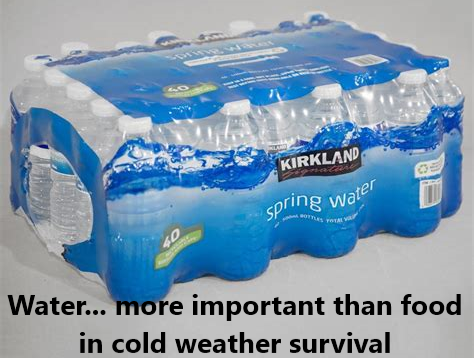
When people hear fuel for the body, they think of food. Correct in part, but that is only a portion of the metabolism and heat equation. In the short run—1 to 5 days—WATER is far more important for warmth than food. More important than in an Arizona heat wave.
The water part of the equation for staying warm in winter is almost totally unknown in the general populace. Worse yet, the majority of preparedness and survival instructors don’t explain the true need for consuming water for warmth. When they talk about drinking water in winter, it’s often casual, like an afterthought.
They say to drink plenty of fluids. Nothing much is said about what kind of fluids, how much, or when. And nothing is explained about the laws of physics and the physiology involved that makes this such a crucial safety subject.
Let me make this absolutely clear. The need for you to stay well hydrated in cold weather is critical for your strength, warmth, and survival. Failure to drink copious amounts of water in cold conditions will profoundly reduce your energy level and the ability to stay warm. I cannot be any more direct or explicit than this.
Dehydration does not just have a minor effect on the body nor do you have to go days without water to feel the impact. To tell this whole story and fully explain it would take several more pages, which we don’t have space or time for. A few more facts and then I’ll give you a resource to learn the complete story on winter hydrating and staying warm.
(From Jack Lawson… Drink more water in freezing Winter than the heat of an Arizona summer!!?? NO ONE ever told me that. This is why Jim Phillips is THE EXPERT on this subject along with the fact he experienced almost freezing to death… like frozen skin, extremities and muscles which almost killed him and started him on his journey of teaching Cold Weather Survival. Go to his website at www.JimsWay.com)
Mild dehydration leads to significantly reduced energy, strength, stamina, and the ability to keep warm; mild dehydration sets in when the individual has lost between 1–3% body weight of water.
Moderate dehydration is reached when the body has lost 4-5% of body weight of water. This causes profound negative effects on energy levels and the ability to stay warm. At this point, if you are not in a heated shelter, hypothermia is in process. It will worsen and become life-threatening if there is no significant improvement in hydration level and warmth.
Death will occur most of the time before reaching 10% loss of body weight of water.
You dehydrate faster in the cold than in the heat. For example, at 0°F you will dehydrate faster than at 100°F.
You must drink much more water than you would think. If you are cold and tired, more than likely you are dehydrated. Drink 2, 3, or 4 cups of water right away, not spread out over the next couple of hours.
To get a total understanding of the topic, I have a video with the full explanation, titled, Hypothermia via the Dehydration Black Hole. Find it at JimsWay.com > Library > Handouts & Links, scroll down to the WELLNESS area.
Here are some recommendations on how to filter, think about, and get the most useful ideas from these other people’s survival cookbook suggestions—a list with a recipe:
- Reread the forgoing sections: A-Your Reality, B-Missing Resources, C-Back to Your Current Reality, D-Your Well-Being. Let the reality and correctness of this settle in so you won’t be blindsided by how things are likely to be.
- Watch my webcast of two classes, Module-9, SUPPLIES, Fuels for living in a Grid-Down World, and Module-8, TOOLS, Lights for a Grid-Down World. Both are on JimsWay.com > Library > Handouts & Links, scroll down to the bottom.
- Read Jack Lawson’s article, Alternative Power-Gasoline and Fuels, and follow his suggested other readings and links in the Civil Defense Manual.
- For much more on hypothermia and dehydration refer to chapter 23 in the CIVIL DEFENSE MANUAL, by Jack Lawson. It’s in Volume-ll, pages 547–567, “HypoThermia: From the Inside Out”, by yours truly. If you don’t have this important two-volume set, get it https://civildefensemanual.com/.
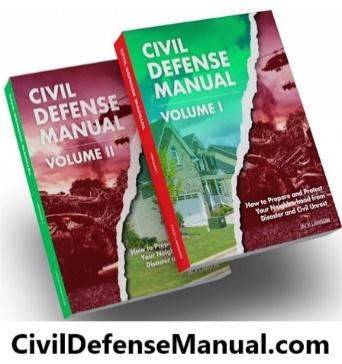
- Download and read The Truth About Emergency Alcohol Can Heaters. This may bring a little reality to some of the other small emergency flame heaters you hear about. Make one and see what it will actually do to heat a cold room before you are freezing.
- At the moment you are not in a winter event without utilities, this is the time to practice and experiment. If things go badly in the practice session you can bail. But when it’s for real, there is no timeout, where you can pause and then come back later. You want things worked out before your life is on the line.
No one has the right to sell, promote, or teach something they have not lived for an extended period. Demonstrating something for a few hours under controlled static conditions so they can post another video does not prove much.
Until you have sure knowledge of something, it is just information, a nice idea, a theory.
KNOWLEDGE equals INFORMATION multiplied by EXPERIENCE… or K = I x E
It is important that the information be true, correct, credible.

With K = I x E as a learning platform and reality sum-check—every day—work to increase your level of understanding so you KNOW that you will be okay in life and beyond. In 1987 Jim personally trained Astronaut James Lovell and two friends for a special trip to the geographic North Pole on the frozen polar ocean. ![]()
Part of Jim Phillip’s philosophy… “Each of our lives is full of choices and opportunities for growth. When life happens, we can either see it as an adventure or a burden… and when it comes again and again the choice is to get bitter or better. May we learn to become more skilled at choosing the better part.”
A Photo Snapshot of James G. (Jim) Phillips, Jr.


Most important of all to Jim was, he had kept and built his greatest asset, the marriage of over 40 years to his wife, Linda. He credits her with the support and resilience to make it all possible during very difficult times.
Jim and his wife have nine children, 22 grandchildren and 2 great grandchildren (so far).
https://www.jimsway.com/store/p5/Winter-Safety-Made-Real.html
From Author Jack Lawson… We take people for granted “just being around” …then they’re gone… and we’re at a loss for words and adrift with feelings.
So, enjoy all others. Smile at them, joke with them, laugh with them… and make theirs and your life happier.
This man touched my life and made it better…
The Author advises the Reader that the Author, the Contributing Authors, Publisher, Copyright Holders, Website Administrators are not attorneys and some recommendations or actions in this book that the Reader takes may lead to loss… financial and otherwise, injury or death. The Author, the Contributing Authors, Publisher, Copyright Holders will not be liable for situations that arise from the Reader’s interpretations or misunderstanding of material in this essay, article, supplement, newsletter, emails, the book A Collapse Of Society, the Civil Defense Manual or the Reader’s instructions to others. Even though the Reader may determine that action or inaction to be as instructed by this book or in the spirit of simple self-defense, it may not be viewed that way by authorities in some States and Locales and the Authors accept no responsibility for your actions. Consult an attorney and apply common sense and their advice in your actions and interpretation of instructions and recommendations from us. Reader’s actions or implementation of recommendations and information or misinformation from this book or essay, article, supplement, newsletter, email… may lead to the Reader’s liability, loss of their money or that of others or other damages or injury or death.. You’re all adults… behave as responsible, safe, compassionate, common sense, lawful adults. Verify your Federal, State and Local laws and ordinances before using the information in this book or essay, article, supplement, newsletter or email. As an adult… make your decisions independent of advice, information or misinformation from A Collapse Of Society, the Civil Defense Manual and any and all other information. Wear big people’s pants and live with the decisions you make as your decisions… made by your independent thinking mind. Don’t blame others for your mistakes or misfortune… and that includes us.

